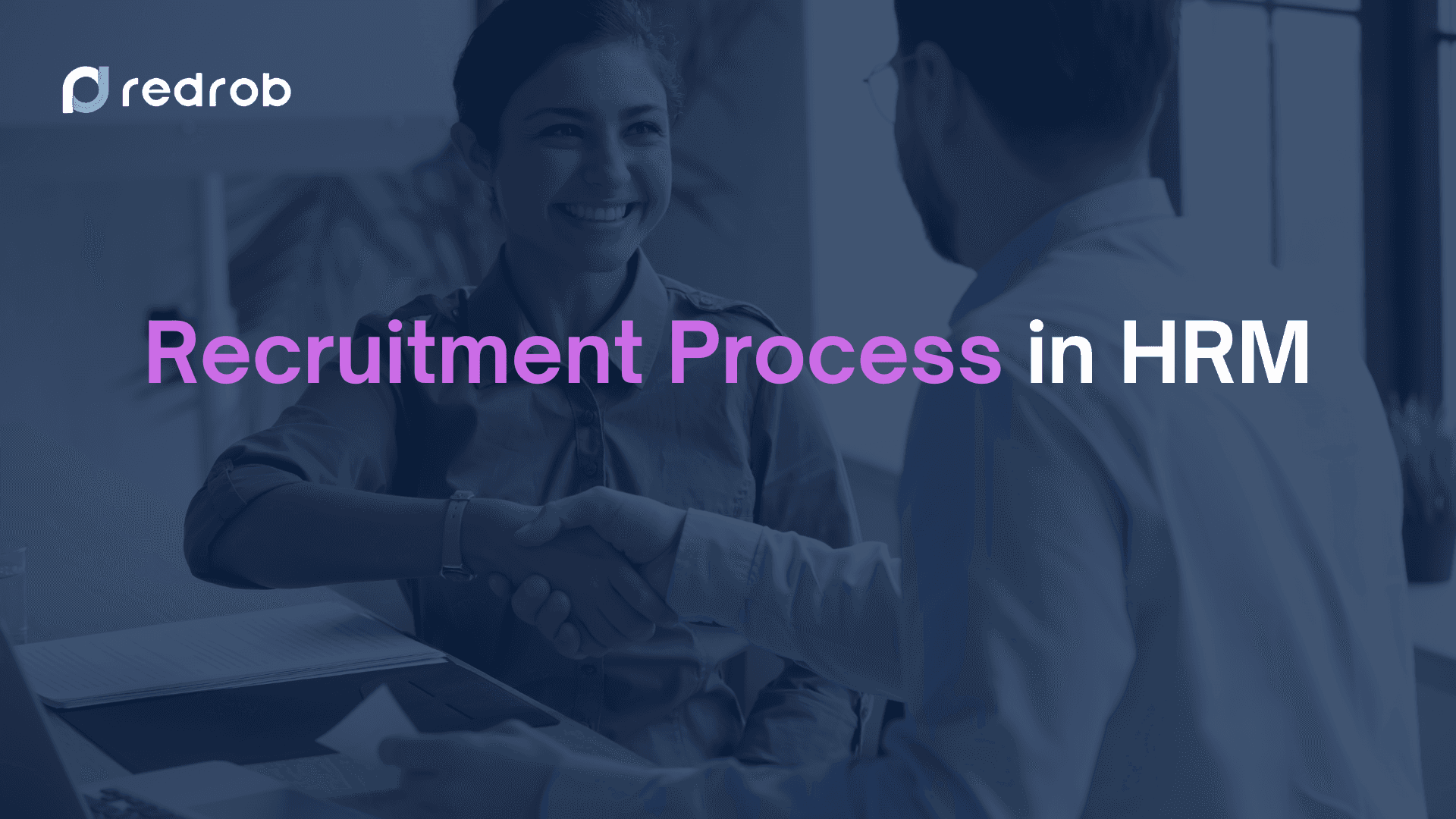Recruitment
What is the Recruitment Process in HRM?

Soumyata Singh
Oct 10, 2024
8 min read
There are various aspects of human resource management and all of them are crucial to ensure that you build a strong, qualified team. Recruitment is a major one of them. It involves finding, attracting, and selecting the right candidates for your organization. Effective recruitment ensures you bring in skilled individuals who align with your company’s goals.
This blog helps you understand what is recruitment in management. Keep reading to know how you can conduct the recruitment process efficiently to onboard the best employees.
What is Recruitment in HRM?
Recruitment is a process in HRM (human resource management) where you identify and attract potential candidates for open positions. It's a crucial step in ensuring that your organization has the right talent to grow and succeed. The purpose of recruitment is simple: find the best candidates and integrate them into your company. This is not just about filling vacancies; it’s about building a strong team that aligns with your organization’s goals and culture.
When asking "what is recruitment in management," you're referring to the system that connects qualified candidates with specific job roles. In HRM, this process is essential for maintaining productivity and employee satisfaction. Effective recruitment also reduces turnover, saving time and resources that would be lost in frequent re-hiring.
Ultimately, the recruitment process ensures you not only meet the immediate needs of your business but also secure long-term talent. For example, an IT company that hires the right software developers through careful recruitment can stay ahead in innovation.
There’s a lot in between finding and onboarding candidates. Let’s understand everything better as we move ahead.
Key Steps in the Recruitment Process
Here’s a step-by-step insight to get a better understanding of what is recruitment in management and what exactly needs to be done.
1. Job Analysis
The recruitment process begins with a clear understanding of your talent needs. Therefore, job analysis is the first and crucial step. It involves identifying the skills and qualifications needed for a role and ensuring that you attract the right candidates. Let's explore how it unfolds.
Conducting a Talent-Needs Assessment for Job Description and Creating Candidate Persona
To hire the right people, you must first assess the company's needs. This involves analyzing your existing workforce and identifying skill gaps. A talent-needs assessment helps you define the job requirements. You then create a detailed job description outlining the duties, responsibilities, and expectations.
Next, build a candidate persona. This is a profile that details the ideal candidate's skills, experience, and traits. It helps to align your recruitment process with the specific needs of the role. For example, if you're hiring for a marketing role, the candidate should have strong communication skills and creativity. Having a clear persona makes it easier to spot the right fit.
Outlining Job and Candidate Profiles with Required Skills
A well-defined job profile clarifies the expectations for the role. This profile typically includes key responsibilities, performance goals, and required qualifications. For example, a software developer’s profile may include coding expertise, problem-solving skills, and teamwork abilities.
Similarly, the candidate profile outlines the experience, skills, and personality traits needed for success in the role. For instance, leadership roles might require extensive experience and a proven track record in managing teams. These profiles ensure that both the recruiter and the candidate understand what’s expected from the start.
Utilizing Recruitment Software and Platforms to Attract Candidates
Recruitment software has transformed how companies attract talent. From job posting to screening, it helps streamline the hiring process. Platforms like LinkedIn, Indeed, and Glassdoor allow you to reach a broader audience. Using recruitment software, you can automate job postings and track applications in real time.
These platforms also offer targeting tools to find candidates that match your job and candidate profiles. According to studies, 79% of recruiters who use an ATS or other recruitment software report higher efficiency in their hiring process. This ensures that you get qualified candidates quickly and efficiently.
2. Candidate Sourcing
Once you've defined your job and candidate profiles, the next step is finding the right talent. Candidate sourcing is a vital aspect when trying to understand what is recruitment in management Sourcing involves tapping into various methods to attract qualified candidates. Let’s look at how this can be done effectively.
Utilizing Various Candidate Sourcing Methods
Internal referrals are one of the most reliable sourcing methods. Employees can refer candidates who fit the role, often resulting in faster hires. In fact, studies show that referred candidates are hired 55% faster than others.
Online portals like LinkedIn, Indeed, and Redrob offer access to a large pool of candidates. These platforms allow you to filter applicants based on location, skills, and experience. You can post your job openings on multiple platforms, broadening your reach and increasing the chances of finding the perfect match.
Media utilization, such as advertising through social media, can also help attract more candidates. Posting job openings on platforms like Facebook or Twitter can generate more applications. This method is especially useful for roles targeting tech-savvy or younger professionals.
Employer Branding for Building a Better Team
Your employer brand can make a huge difference in attracting top talent. When candidates view your company as a great place to work, they are more likely to apply. A strong employer brand builds trust and interest, which can be a game changer in recruitment.
For example, companies with a positive employer brand see a 50% increase in qualified applicants. Showcasing employee testimonials, work culture, and company values online can greatly impact candidate interest. A well-defined employer brand also makes candidates more eager to integrate into your organization.
3. Screening and Selection Procedures
Once you've sourced potential candidates, the next step is screening and selection. This phase ensures you identify the most qualified individuals, helping you answer the question, "what is recruitment in management?" Proper screening and selection ensure only the best candidates move forward.
Initial Screening Using AI and Recruiting Tools
Initial screening can be time-consuming without the right tools. Today, many companies use AI-driven software to handle the first round of screening. These tools automatically filter applications based on pre-set criteria like skills, experience, and qualifications.
For example, Applicant Tracking Systems (ATS) can scan resumes and identify keywords related to the job description. This makes it easier to shortlist the most relevant candidates.
Redrob’s comprehensive applicant tracking system can help you save 60% of candidate screening time. Know more about our ATS.
Conducting Interviews and Assessments
Once you've shortlisted candidates, the next step is conducting interviews. Interviews allow you to assess the candidate’s communication skills, job knowledge, and cultural fit. It’s important to ask targeted questions that reflect the requirements outlined during job analysis.
Skills assessments are another useful tool. These tests measure a candidate's ability to perform tasks directly related to the job. For example, a coding test for a software developer can give you real-time insight into their capabilities.
Psychometric testing is also becoming more common. It evaluates personality traits, problem-solving skills, and how candidates work under pressure. This additional data can help predict future job performance.

Compiling and Assessing Qualified Applicants for Further Interview Rounds
After the initial interviews and tests, it’s time to narrow down your candidates. Compile the results from interviews, tests, and background checks to assess which applicants are best suited for the next round. Review the candidates’ qualifications and compare them against the job profile to ensure a strong match.
For example, if you’re hiring for a management position, you may want to compare candidates' leadership experience, communication skills, and past achievements. This structured assessment ensures the most qualified individuals move on to the final interview rounds.
4. Final Selection and Job Offer
After screening and assessments, it’s time to make the final decision. This step in the recruitment process is all about securing the best candidate with a well-negotiated offer. Let’s get a better understanding of the final selection and job offer phase.
Negotiating Terms and Extending the Offer Letter
Once you’ve identified your top candidate, you need to discuss the offer. Start by negotiating the terms. This includes salary, benefits, and other perks. Make sure the terms align with both company policies and the candidate's expectations.
Once both parties agree on the terms, you can extend the official offer letter. The letter should outline all the key details of the role, including responsibilities, salary, and any conditions of employment. Extending a clear and formal offer ensures there’s no confusion about the job expectations.
Performing Reference and Background Checks Prior to Offering
Before the offer becomes official, it’s necessary to perform reference and background checks. Contacting previous employers or professional references helps you confirm the candidate’s qualifications and work history. This step adds an extra layer of verification, ensuring the candidate is a good fit for the role.
Background checks can include verifying educational credentials, employment history, and criminal records. Many companies conduct background checks to reduce the risk of a bad hire. These checks ensure you maintain high standards and hire reliable employees.
5. Onboarding of New Employees
Onboarding is the final step in bringing new hires into your team. A well-planned onboarding process plays a vital role in successful recruitment. It helps new employees adjust quickly and feel comfortable in their new roles. Let’s explore the key elements of effective onboarding.
Integrating New Employees Through Structured Onboarding
A structured onboarding program ensures that new hires feel welcomed and prepared. Start by introducing them to the company’s policies, team, and processes. Structured onboarding often includes training sessions, mentorship, and regular check-ins during the first few weeks.
According to research, organizations with a structured onboarding process experience over 50% greater new hire retention. When new employees know what to expect, they are more likely to stay engaged and productive from day one. For example, assigning a mentor can help guide them through tasks and provide support during their transition.
Ensuring a Smooth Transition and Alignment with Company Culture
Onboarding goes beyond paperwork—it’s about ensuring a smooth transition into the company culture. Helping new employees understand the values, mission, and work environment makes them feel more connected. This cultural alignment ensures they fit well within the team.
One way to align new hires with your culture is through team-building activities or social events. For example, some companies hold casual welcome lunches or coffee meetings with key team members. This fosters a sense of belonging and helps build relationships early on. Employees who feel aligned with the company culture are more likely to stay.
Trends and Best Practices in Recruitment
Staying current with recruitment trends is essential for maintaining a competitive edge. While you know what is recruitment in management, you must also understand the importance of constantly adapting to new techniques and tools that improve efficiency and results. Let’s explore some modern trends and best practices in recruitment.
Modern Recruitment Techniques and Tools

Recruitment technology continues to evolve. Modern tools like AI, automation, and video interviews make the hiring process faster and more efficient. For instance, AI-powered recruitment platforms can help you sort through applications quickly. These tools screen candidates based on keywords, skills, and qualifications, saving time for HR teams.
Another trend is video interviews, which have grown in popularity, especially for remote hiring. This method allows you to interview candidates regardless of location, making it easier to access a wider talent pool.
Virtual job fairs and social media recruiting are also on the rise. These approaches allow companies to reach more candidates in real-time. Adopting these techniques not only improves efficiency but also helps you stay competitive in a fast-paced job market.
Implementing Centralized Data Management for Legal Safety and Enhanced Efficiency
Centralized data management is now a best practice in recruitment. By storing all candidate information, resumes, and interview feedback in one secure system, you reduce the risk of legal issues. Proper data management helps you comply with data privacy laws like GDPR and ensure that sensitive information is handled responsibly.
Efficient data management also enhances productivity. With a centralized system, you can easily track a candidate’s progress throughout the recruitment process. This keeps your recruitment team organized and ensures that no details are overlooked.
Streamline Your Recruitment Process With Redrob
A well-executed recruitment process is crucial for organizational success. It ensures you hire skilled individuals who align with your company’s values. We hope now you have a clear idea about what is recruitment in management. It’s not just about filling roles quickly; it’s about finding the right fit for long-term success.
By aligning recruitment with HRM objectives, you build a strong, motivated team. A systematic approach improves efficiency, reduces turnover, and boosts employee satisfaction. Effective recruitment drives growth, helping your business achieve its goals.
Recruitment tools like Redrob offer you a complete platform to centralize all your recruitment tasks. From sourcing candidates to assessing them for various skills, it makes things easier for you.
What do you get with Redrob?
A state-of-art ATS for overall tracking
AI-powered job posts and profile ranking
Customizable assessment tests
Price plans for your specific hiring needs
Check out our solutions to know more and save 88% of hiring costs.
